NVIDIA’s GeForce GTX 590: Duking It Out For The Single Card King
by Ryan Smith on March 24, 2011 9:00 AM ESTMeet The EVGA GeForce GTX 590 Classified, Cont.
Now that we’ve had a chance to discuss the GTX 590 reference hardware, let’s touch on the rest of EVGA’s package. As we previously noted the EVGA GeForce GTX 590 Classified is being positioned as a premium product with a $30 price premium, so let’s see why.
We’ll start with the box—the box EVGA is using is quite simply enormous. EVGA will be selling both single GTX 590s and pairs of GTX 590s using the same box, so the resulting box is big enough to carry two cards. Presumably this isn’t being sold in any retail stores, as a result the box is nearly blank save for the product name on the front.
In order to sell the idea that this is a premium product, EVGA is also packing in some extras with the card. Honestly there’s probably nothing in here that’s going to be of great utility to you except possibly the mouse pad, but clearly EVGA thinks otherwise:
- EVGA Shirt (XL)
- EVGA Poster
- EVGA Branded Gaming Surface (XL Mouse Pad)
- 2x 6pin-to-8pin PCIe power adaptors
- Display adaptors: DVI-to-VGA, DVI-to-HDMI, miniDP-to-DP
- Driver/demo/utility CD
- Non-generic GTX 590 Quick Start Guide
- Redemption offer for 3DMark 2011 Advanced Edition
EVGA is offering up their usual suite of overclocking tools with the GTX 590, however only EVGA Precision is on the disc. EVGA OC Scanner and ELEET can be downloaded from EVGA’s website.
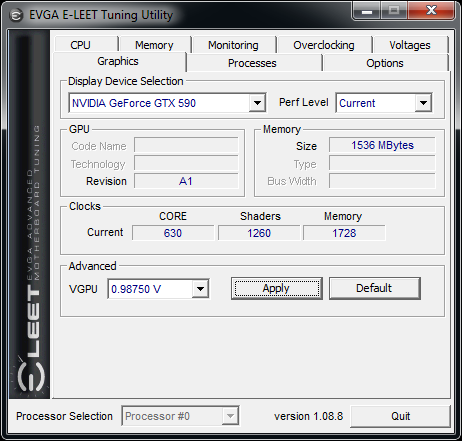
Of the software tools we’ll start with ELEET, as this is the only tool we haven’t covered before. EVGA has had ELEET for some time now for their motherboard business, as it’s their principle motherboard overclocking tool. However at the end of last year they added GPU voltage control through the utility, finally allowing users to overvolt their GPUs using only EVGA tools. We’re glad to see EVGA went with a less-is-more approach with the design of the utility, ditching any funky skinning and focusing on usability. One thing ELEET does that we have not seen on any other utility is that EVGA allows for controlling the voltage for more than just 3D Game clocks; idle and low-performance voltages can also be controlled. We’re assuming the purpose here is to undervolt those modes rather than to overvolt them, as the latter is counterproductive.
At this point ELEET’s only notable weaknesses are related to the fact EVGA implemented voltage control separately from EVGA Precision’s overclocking support. As a result you need to launch ELEET separate from Precision to set any voltages if your overclocked settings require overvolting, and at the moment ELEET does not have any kind of profile support, meaning you have to manually dial in the voltages on every boot. This isn’t utility breaking, but there’s a clear potential for annoyance. EVGA tells us they will be fixing this in the future.
Update: April 2nd, 2011: Starting with the 267.91 drivers and release 270 drivers, NVIDIA has disabled overvolting on the GTX 590 entirely. So while everything we've written about ELEET remains, with the GTX 590 Classified it is effectively rendered obsolete.
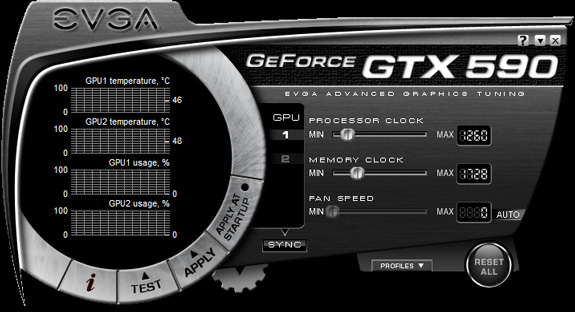
The next utility in EVGA’s suite is of course EVGA’s fantastic EVGA Precision overclocking tool. Based on the famous (and now discontinued) RivaTuner, Precision is a custom-skinned and up to date utility based on RivaTuner technology. It features per-GPU overclocking controls, an OSD overlay, and hardware monitoring/logging. Alongside MSI’s Afterburner, we believe it sets the gold standard for GPU overclocking/monitoring utilities.
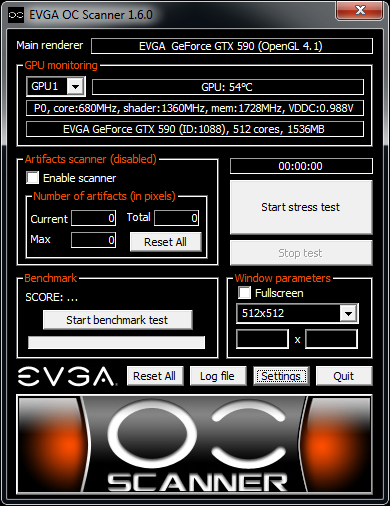
The final utility in EVGA’s suite is the EVGA Overclock Scanner. In a nutshell, the OC Scanner is a load-generating utility (ala Furmark) which rather than generating a moving image generates a static image. By generating a static image it’s possible for the software to identify any rendering errors in the image that would be indicative of a bad overclock. Or in other words, if you’ve overclocked your card too far, this utility will let you know. With the wider range of overclocking options afforded by ELEET, OC Scanner takes on an additional degree of importance for establishing both stability and safe operating temperatures, nicely rounding out EVGA’s software suite. All told the suite should cover 99.9% of most users’ overclocking needs.
Wrapping things up, as is customary for their high-end cards, EVGA is offering a lifetime warranty for the GTX 590, so long as the card is registered within 30 days. Notably overclocking does not void the lifetime warranty (this turned out to cause quite a bit of commotion with the 6990). Altogether, the entire EVGA GeForce GTX 590 Classified package has an MSRP of $729.


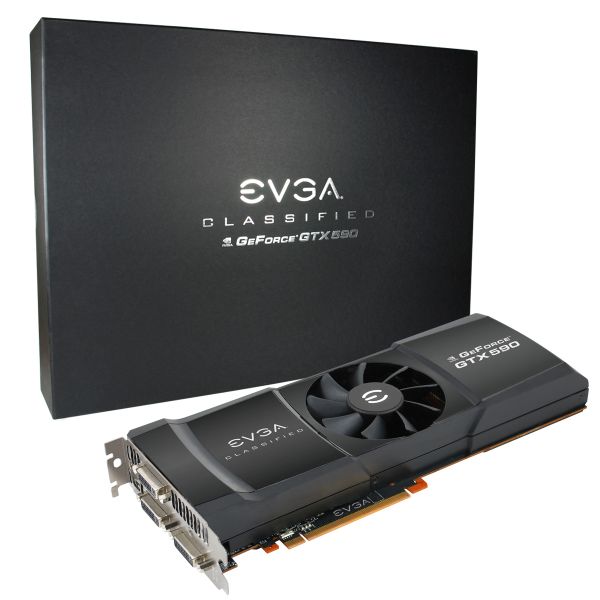
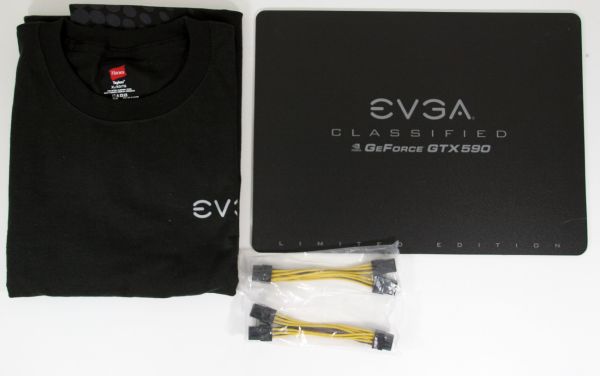








123 Comments
View All Comments
valenti - Thursday, March 24, 2011 - link
Ryan, I commented last week on the 550 review. Just to echo that comment here: how are you getting the "nodes per day" numbers? Have you considered switching to a points per day metric? Very few people can explain what nodes per day are, and they aren't a very good measure for real world folding performance.(also, it seems like you should double the number for this review, since I'm guessing it was just ignoring the second GPU)
Ryan Smith - Thursday, March 24, 2011 - link
Last year NVIDIA worked with the F@H group to provide a special version of the client for benchmark purposes. Nodes per day is how the client reports its results. Since points are arbitrary based on how the F@H group is scoring things, I can't really make a conversion.poohbear - Thursday, March 24, 2011 - link
Good to see that a $700 finally has a decent cooler! Why would somebody spend $700 & then go and hafta spend another $40 for an aftermarket cooler??? nvidia & AMD really need to just charge $750 and hve an ultra quiet card, these people in this price range are'nt gonna squabble over an extra $50 for petes sake!!!! it makes no sense that they skimp on the cooler at this price range! this is the top of the line where money isnt the issue!Guspaz - Thursday, March 24, 2011 - link
Let's get this straight, nVidia. Slapping two of your existing GPUs together does not make this a "next-generation card". Saying that you've been working on it for two years is also misleading; I doubt it took two years just to lay out the PCB to get two GPUs on a single board.SLI and Crossfire still feel like kludges. Take Crysis 2 for example. The game comes out, and I try to play it on my 295. It runs, but only on one GPU. So I go looking online; it turns out that there's an SLI profile update for the game, but only for the latest beta drivers. If you install those drivers *and* the profile update, you'll get the speed boost, but also various graphical corruption issues involving flickering of certain types of effects (that seem universal rather than isolated).
After two goes at SLI (first dual 285s, next a 295), I've come to the conclusion that SLI is just not worth the headache. You'll end up dealing with constant compatibility issues.
strikeback03 - Thursday, March 24, 2011 - link
And that is why people still buy the 6970/580, rather than having 2 cheaper cards in SLI like so many recommend.JarredWalton - Thursday, March 24, 2011 - link
For the record, I've had three goes at CrossFire (2 x 3870, 4870X2, and now 2 x 5850). I'm equally disappointed with day-of-release gaming results. But, if you stick to titles that are 2-3 months old, it's a lot better. (Yeah, spend $600 on GPUs just so you can wait two months after a game release before buying....)Guspaz - Friday, March 25, 2011 - link
I don't know about that, the original Crysis still has a lot of issues with SLI.Nentor - Thursday, March 24, 2011 - link
"For the GTX 590 launch, NVIDIA once again sampled partner cards rather than sampling reference cards directly to the press. Even with this, all of the cards launching today are more-or-less reference with a few cosmetic changes, so everything we’re describing here applies to all other GTX 590 cards unless otherwise noted.With that out of the way, the card we were sampled is the EVGA GeForce GTX 590 Classified, a premium GTX 590 offering from EVGA. The important difference from the reference GTX 590 is that GTX 590 Classified ships at slightly higher clocks—630/864 vs. 607/853.5—and comes with a premium package, which we will get into later. The GTX 590 Classified also commands a premium price of $729."
Are we calling overclocked cards "more-or-less reference" cards now? That's a nice way to put it, I'll use it the next time I get stopped by a police officer. Sir, I was going more or less 100mph.
Reference is ONE THING. It is the basis and does not waver. Anything that is not it is either overclocked or underclocked.
strikeback03 - Thursday, March 24, 2011 - link
Bad example, as in the US at least your speedometer is only required to be accurate within 10%, meaning you can't get ticketed at less than 10% over the speed limit. This card is only overclocked by 4%. More importantly, they a) weren't sent a reference card, and b) included full tests at stock clocks. Would you rather they not review it since it isn't a reference card?Nentor - Thursday, March 24, 2011 - link
That is a good point actually, I didn't think of that.Maybe reject the card yes, but that is not going to happen. Nvidia is just showing who is boss by sending a non reference card. AT will have to swallow whatever Nvidia feeds them if they want to keep bringing the news.